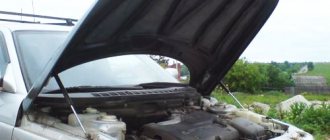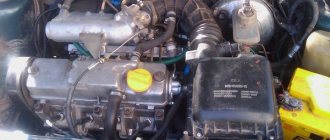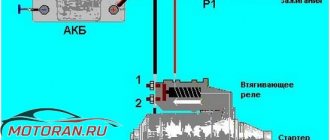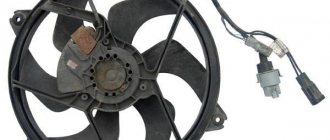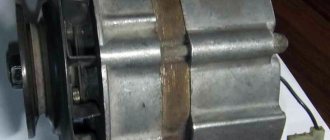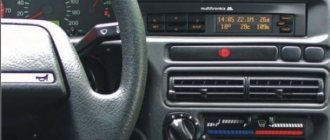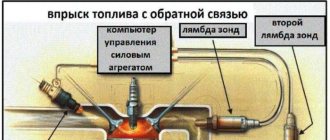If, when turning the key in the ignition switch, the starter simply clicks, but does not turn and, as a result, the engine cannot start, the reason here is quite simple and now we will deal with it in detail.
It's clear that when a car doesn't start right away, it annoys any motorist. The reasons are as follows: the contacts on the battery may simply become disconnected, and there may also be a malfunction in the starter. But an experienced driver, based on certain signs and clicks, will always be able to understand in which particular unit the malfunction occurred.
The starter and retractor relay clicks, what is the reason?
If the starter clicks on a VAZ 2114 and does not turn, then everything immediately becomes clear . These clicks come from the solenoid relay, but this does not mean that you need to change the starter solenoid relay. Current flows to it, which is why it clicks.
If these devices click, then this is not bad, because if there are clicks, then these devices are operational or partially operational.
In most cases, solenoid relays use an electromagnetic method to connect contacts.
When voltage is applied, the contact terminals receive charges with opposite poles, so they begin to attract and when they touch each other, they create a clicking sound.
In order for the engine to start, you need to make sure that these components are in good working order:
- the battery is charged with well-connected terminals;
- The ignition switch and its contacts must be in order;
- the starter relay, the solenoid relay and the starter itself.
Video tip: The starter clicks but does not turn:
After turning the ignition key, the starter clicks, but the engine does not turn over with the starter
If the engine does not start from the starter, then there is a high probability of various malfunctions of this device. One common starter problem is that the starter clicks or hums, but does not turn the engine. In other words, the driver turns the ignition key and hears distinct clicks or a hum from the starter instead of starting the engine (the crankshaft does not turn from the starter). Next, we will look at the main reasons why the starter clicks, but the engine does not turn over.
The clicks that the driver hears when trying to start the engine are the clicking of the starter traction relay. The specified starter relay structurally includes two types of windings. One of the windings is called the pull-in winding, the other is called the holding winding.
The starter clicking when starting means that the clicks are coming from the traction relay. This happens because the retractor winding retracts the relay core, but as a result of the reduced voltage on the holding winding, the core releases.
The longer the ignition key is held in the “start” position, the more times the retracting winding will retract the core, and the holding winding will release it.
Such a malfunction is accompanied by the indicated clicking of the starter, which is actually clicks of the traction relay. Let us add that the traction relay (pull-in) has a similar design and operating principle on most vehicles, regardless of the make and model of the car.
The relay clicks, but the car does not start, what should I do?
As you understand, if there are clicks, then there is still hope that the car will be able to start. If the starter does not spin, you should definitely pay attention to the contacts of the traction relay. Therefore, the first thing you need to check is the following:
- battery, clean the terminals, perhaps there is simply no contact;
- check if the wires leading from the battery to the starter are in order;
- twitch the key in the ignition switch, perhaps there is a contact somewhere;
- the starter is broken, in this case you will have to remove it and reassemble it, but before that you need to make sure that there is no contact on the brushes;
- If the solenoid relay is broken, then you will just have to replace this unit.
Usually, the starter breaks down quite rarely, and so does the solenoid relay, so most likely it’s all about a discharged battery or missing contacts. If the battery has a weak charge, then it is clear that there will not be enough energy to turn the starter, but it may be enough to operate the charge relay, which is why these clicks are heard.
There are times when the starter takes over the current.
Clicking sounds are heard, but the starter does not turn due to the windings or brush assembly
If the battery, ignition switch, contacts, wiring and starter relay are checked, but it still does not rotate when you turn the ignition key, then the problem is directly in the starter. In such a situation, you will have to completely remove it from the car, disassemble it and evaluate the possibility of repairs. You can also simply replace the starter with a new one.
If you decide to repair the starter yourself, know that the problem with it refusing to rotate under load may be due to:
- Faulty winding, which has a characteristic burnt color and smell;
- A faulty brush assembly, the wear of which is easily determined visually.
Starters are rarely repaired, and such a step should only be taken as a last resort. If it is possible to replace the starter, then it is better to do this than to bother with repairing the winding or brush assembly.
( 408 votes, average: 4.57 out of 5)
How to change the air filter
Coolant (antifreeze, antifreeze) in the cylinder block
Related Posts
How to check the starter
If everything is fine with the battery and the contacts too, then the problem is in the starter. and clicks for this reason . What should I do if the starter clicks but does not turn? To diagnose it and find out where exactly the clicks are coming from, you will have to remove the starter.
You may also be interested in: The best Italian cars: Ferrari, Lamborghini, Maserati and others
Then you need to put this starter on the table, take a charged battery and connect ground to the starter body, and connect the positive terminal to the pin that comes after the relay. If the starter turns, then everything is in order and there are no problems with the retractor relay either. And if the starter clicks, but does not turn as before, this means that there is a malfunction in it and you will have to disassemble it and look for the breakdown inside . The same must be done if the starter idles and does not engage.
Causes of malfunction
Before we begin to study the causes of the malfunction, we remind you that hereinafter we are talking about the crackling noise of the starter, which is most similar to the loud rattling of the contacts of an electromagnetic relay. If you hear an unpleasant metallic grinding noise from under the hood, then it appears due to poor engagement of the overrunning clutch (starter Bendix) with the flywheel teeth - that’s a completely different story.
Most often, the starter crackles when you turn the ignition key for three reasons:
Low battery
To understand the cause of the crackling noise due to a discharged battery, let's remember the starter device. When you turn the ignition key, the voltage from the on-board network is supplied to the coil of its solenoid relay. The electromagnetic forces that appear in this case cause the armature of the device to move. It closes the power contacts that connect the starter motor to the battery, and in addition, causes the Bendix gear to engage with the flywheel.
When the battery is discharged, its energy may be enough to attract the metal core - cranking the crankshaft is out of the question. As soon as the starter contacts close and power is supplied to its electric motor, the voltage drops to such an extent that the electromagnet is unable to hold the metal core. Under the action of the return spring, it tends to take its original position and opens the power contacts. The restored voltage contributes to the repeated retraction of the anchor, and the situation is recreated many times.
To make sure that the culprit of the problem is a deep discharge of the battery, just turn on several consumers (lighting, electric heater motor, etc.) and press the sound signal. The latter will either not turn on at all, or will be heard with wheezing, reduced amplitude or attenuation.
Poor engine ground contact
The picture of what is happening is practically indistinguishable from the case discussed above, with the only difference that the test for battery discharge ends with a negative result - all consumers, including the sound signal, are working at full strength.
At the same time, it is very simple to determine that the cause of the malfunction is poor contact between the battery and the engine - just pay attention to the oil pressure warning lamp, which is located on the instrument panel. If the voltage in the car’s on-board network is below normal, then turning the ignition switch to the “Start” position will lead to a gradual attenuation of the brightness of the warning lamp (like all others).
In the case where the cause of the crackling sound of the starter solenoid relay is a bad ground, an attempt to start the engine will lead to its complete extinction in time with the clicks of the solenoid relay. At the same time, other indicators practically do not change the intensity of the glow.
Everything is explained very simply - the “mass” of the oil pressure sensor, as well as the starter, is the housing. Therefore, as soon as the electrical contact between the engine and the battery is lost, both of these devices stop working synchronously.
The relay clicks, but the car does not start, how to start the car?
It seems like such a small unit, but it could be the reason why the car won’t start . But if you have a VAZ 2121 or any other VAZ with a manual transmission, then there is an excellent way out of the situation - just take and start the car from the pushrod. To do this, you need to turn the key, as you usually turn it when you want to start the car.
Then find several people and the whole crowd needs to push the car and continue to push it until the speed becomes more or less normal - about 5 km/h or more. At this moment you need to squeeze the clutch, engage 2nd gear and release the clutch, the car will jerk and should start, you need to give the gas at the moment when the car tries to start. If the car stalls, you need to repeat these steps. If it doesn’t stall, then you can drive on without stopping.
And you have to drive carefully so that the car doesn’t stall at a traffic light, and of course, you don’t have to turn off the engine yourself. If there is no one around to ask to push the car, then you need to look for a hill nearby and push the car yourself up to this hill and drive off it. When the car starts to roll down the hill, you can also turn the ignition key and engage second gear and release the clutch.
In general, the car will start this way without a starter and without a battery..
Video advice is a useful way to get out of a situation where the starter clicks but does not turn:
Bushings
Bushings (aka bearings) are located in front and behind the starter. They are responsible for rotating the device shaft. If these elements are worn out, the starter will start clicking, but will not turn. Problems with bushings can also be caused by the fact that the starter is installed incorrectly, that is, it does not occupy the desired position along the axis. Or the winding could short-circuit. In this case, see the previous paragraph.
Healthy! Also, problems with the bushings will be indicated by “heavy” cranking of the starter, even if the engine is well warmed up.
Although many do not consider bearing failure to be a serious failure, they need to be replaced. Otherwise, the starter shaft will jam, which in turn can cause a fire.
